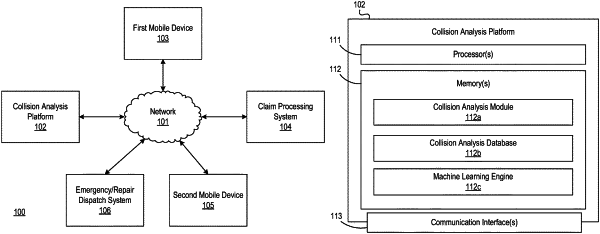| CPC G07C 5/008 (2013.01) [B60R 21/00 (2013.01); G06N 20/00 (2019.01); G08G 1/202 (2013.01); B60R 2021/0027 (2013.01)] | 20 Claims |

|
1. A system comprising:
a claim processing computing system configured to receive a request to initiate a claim from a mobile computing device;
a dispatch computing system configured to receive one or more dispatch commands and dispatch personnel;
a collision analysis computing platform, comprising:
at least one processor;
a communication interface communicatively coupled to the at least one processor; and memory storing computer-readable instructions that, when executed by the at least one processor, cause the collision analysis computing platform to:
receive sensor data from the mobile computing device;
generate, by applying one or more machine learning algorithms to the sensor data, a collision output indicating whether or not a collision occurred;
in response to generating the collision output indicating that the collision occurred:
identify a data collection location corresponding to the sensor data;
determine whether or not the data collection location is within a predetermined radius of a false positive collection location;
in response to determining that the data collection location is within the predetermined radius, modify the collision output to indicate that the collision did not occur;
in response to determining that the data collection location is not within the predetermined radius;
analyze telematics data included in the sensor data to compute a first likelihood of collision score;
compare the first likelihood of collision score to a predetermined collision threshold; and
in response to determining that the first likelihood of collision score does not exceed the predetermined collision threshold, modify the collision output to indicate that the collision did not occur; and in response to determining that the first likelihood of collision score exceeds the predetermined collision threshold, affirm the collision output indicating that the collision did occur; and
send the one or more dispatch commands to the dispatch computing system, when the collision output indicates that the collision did occur, to cause the dispatch computing system to dispatch the personnel to a location of the collision.
|